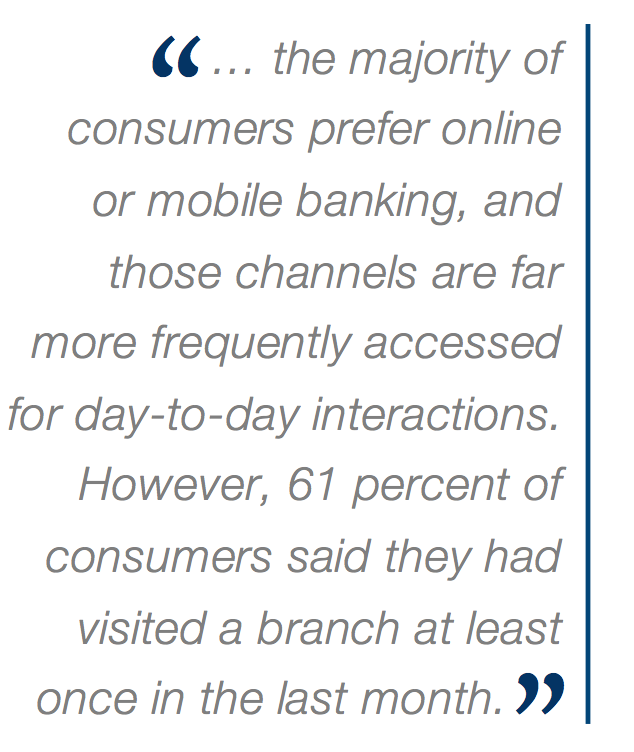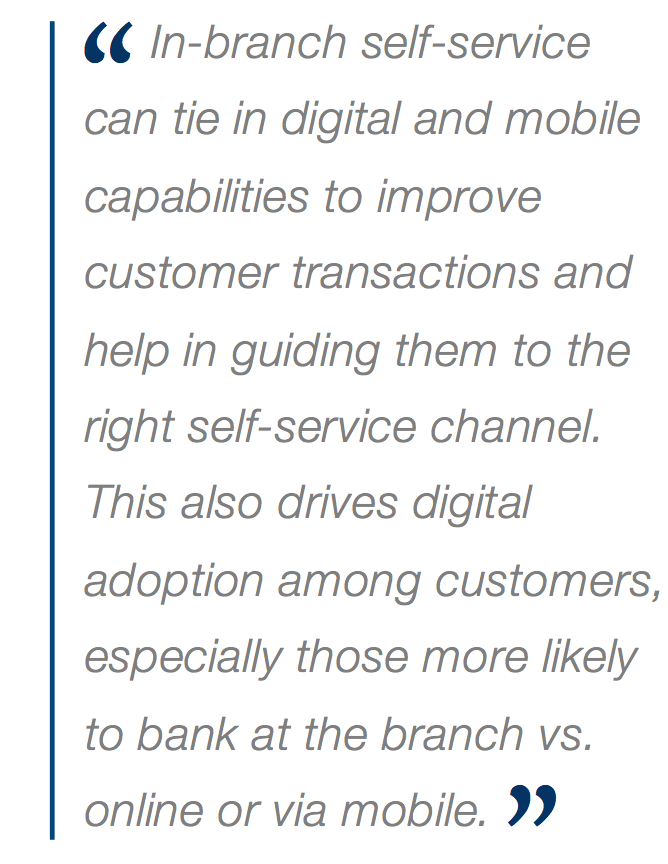Article
How are you driving digital engagement in the branch?
Evolving technology has enabled financial institutions to answer today's consumer expectations for better, more convenient banking. That focus on the customer experience can extend to the branch and help create a more modern and unified experience across channels.

January 12, 2017
by Jamie Dominguez, Market Strategy Director, Bank Solutions, Fiserv
The growth of digital technology has had a profound impact on the way people manage their finances and interact with their financial institutions, and that impact has not been limited to online or mobile banking. Newer digital capabilities are also transforming how people bank in person. This could range from a virtual branch in which no staff is onsite to enhancements such as faster authentication and more personalized interactions in a more traditional branch setting.
While we are living in an increasingly digital world, the majority of consumers still visit the branch. According to the Expectations & Experiences: Channels and New Entrants quarterly consumer trends survey from Fiserv, the majority of consumers prefer online or mobile banking, and those channels are far more frequently accessed for day-to-day interactions. However, 61 percent of consumers said they had visited a branch at least once in the last month.
 Evolving technology has enabled financial institutions to answer today's consumer expectations for better, more convenient banking. That focus on the customer experience can extend to the branch and help create a more modern and unified experience across channels.
Evolving technology has enabled financial institutions to answer today's consumer expectations for better, more convenient banking. That focus on the customer experience can extend to the branch and help create a more modern and unified experience across channels.
The connection between digital and in-branch experience may be best exemplified by the use of online or mobile banking to book appointments prior to entering the branch. This direct digital connection can also be seen with solutions such as CardFree Cash, which enables customers to withdraw money from an ATM using a mobile phone without the use of a physical card.
Retail devices, such as beacons, are now enabling financial institutions to detect the presence of their customers when they are close to a bank location or when they enter a branch. Bank personnel can provide even better service after being alerted that a specific customer has entered the branch, by having the customer profile on hand before interacting with them. In turn, the use of beacons can benefit customers by alerting them when a branch is nearby or informing them of tailored marketing offers.
Within the branch, teller, personal banker and other functions are transforming into cross-functional and consultative roles in order to grow customer relationships, all enabled by technology. The use of mobile devices, tablets, biometric authentication, beacons and virtual interactions have enabled a significant transformation in the way consumers bank and how financial institutions interact with those consumers within the branch.
Biometric authentication can replace inefficient, manual processes that hinder personal interaction. Gone are the awkward moments of scrambling for photo IDs or account numbers. One form of biometric authentication, palm authentication, uses near-infrared sensors to authenticate customers based on their palm vein pattern, a technology that has proven to be well-accepted by consumers. This form of authentication is appearing in some branches in teller lines or teller pods, and could be extended to the ATM. Other financial institutions are rolling out authentication via iris scans.
 In addition to in-person interactions, virtual interactions have found their way into many financial institution branches in the form of virtual teller machines and personal teller machines. These cost-effective alternatives can provide customers with access to specialty staff who may not be on-site in every branch, and with self-service options and the ability to learn about and try new services. Customers can accomplish their banking tasks quickly, with or without the assistance of a bank employee.
In addition to in-person interactions, virtual interactions have found their way into many financial institution branches in the form of virtual teller machines and personal teller machines. These cost-effective alternatives can provide customers with access to specialty staff who may not be on-site in every branch, and with self-service options and the ability to learn about and try new services. Customers can accomplish their banking tasks quickly, with or without the assistance of a bank employee.
Adding self-service to the branch acknowledges that customers want to interact with their financial institution in a variety of ways. Identifying the needs, or top needs, of customers and knowing what they will want to do themselves will help in implementing changes and new capabilities. Marketing those capabilities is also key so financial institutions ensure customers do not default to tellers or bank staff to complete tasks they could conduct on their own. In-branch self-service can tie in digital and mobile capabilities to improve customer transactions and help in guiding them to the right self-service channel. This also drives digital adoption among customers, especially those more likely to bank at the branch versus online or via mobile.
Ultimately, financial institutions should work to clearly define the experience they want to create within each branch. Each location should answer the need for the customer base in that area. Not all branches will be alike, just as not all customers are alike. Integrating digital technology to enhance the in-branch experience benefits both the customer and financial institution. A satisfied customer is a loyal customer, no matter how they bank.
photo istock








